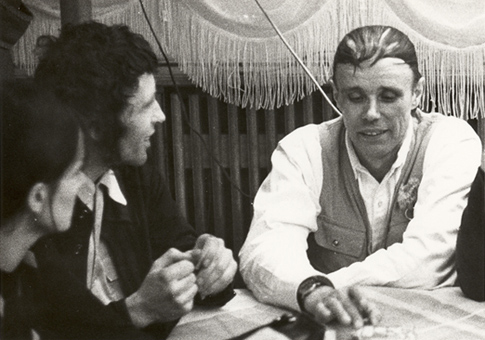

| Günter Saree |
 Günter Saree and Joseph Beuys at the opening of a Beuys Exhibition, Galerie Klein, Bonn, April 10th, 1973 courtesy Erhard Klein, Bad Münstereifel The works of the artist Günter Saree are heavily influenced by performance and concept art; characterised by linguistic structures and immateriality, they were often executed in public spaces. Within the context of one of his later works, the Projekt zur Verkürzung der bewussten Lebenszeit [Project for Shortening the Conscious Time of Life], conceived for the documenta 5 in 1972, visitors were intended to be able to undergo a brief narcosis with the help of an anaesthetist. Forms they had to fill in beforehand informed them about the usual mortality rate (1:6000) of such a narcosis and contained questions regarding their preferences as to a funeral, should the need arise. A certificate subsequently presented to them was supposed to attest to the gap in their consciousness, the event however, was prevented through intervention by the Hessian Medical Association. If, in this happening, Saree introduced the taboo subject of death into the context of art rather casually, he took a far more extreme step in the following year. Meanwhile incurably ill with cancer himself, he now made his own dying and death into a subject of his work for public consideration. Up until just before his death in May 1973, he went to exhibition openings – most often equipped with a tape recorder – where he involved the people present in conversations on death and how they imagined it. As artefacts various audio documents as well as photographs and signed X-ray-images of his cancer-stricken body testify to the way he himself dealt with it. To make certain that he would be able to experience his death as he wished and "genuinely," from March 1973 onwards he carried a shroud he had designed with him, intending to put it on, even if he should collapse: "I AM GÜNTER SAREE AND I AM DYING. REMAIN CALM. CALL ONLY MY FRIENDS. COLOGNE 235837/249494/445704. REGARDLESS OF HOW MUCH I MAY SCREAM TO RELIEVE MY PAIN, NO DOCTOR MAY FALSIFY MY DEATH WITH ANY DRUGS." In his final actions, Saree variously challenged the taboo surrounding dying and death: they testify, on one hand, to the desperation of a man terminally ill and to his wish not to depart unnoticed, and so they simultaneously anticipate today's discussions on determining our own dying. Above all, Saree treated the issue of how art treats death with arguable consistency (and not just representationally), irrevocably erased the boundaries between dying and performance, between life and art and so already anticipated the debate on Gregor Schneider's room for a dying person Günter Saree, * 1940 in Eger (CZ), † 1973 in Cologne (D)  Günter Saree, documentary material, 1972–1973 courtesy Prof. Reiner Speck, Köln, und Erhard Klein, Bad Münstereifel photo: Franz Fischer, Bonn Günter Saree, Sterbetuch, 1973 (Rekonstruktion, 2008) Joachim Hirling, ZKM | Center for Art and Media Karlsruhe, 2008
|